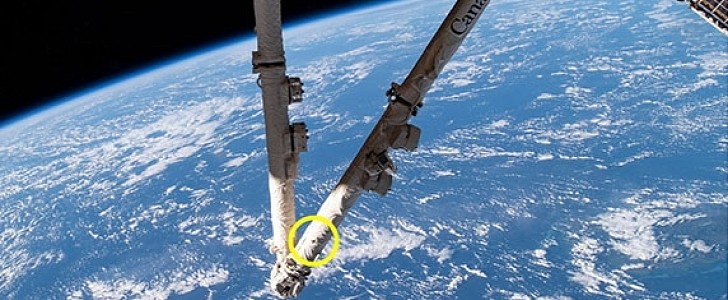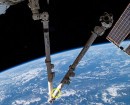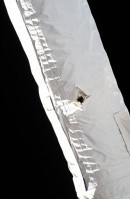We just got a reminder that space junk is out there, orbiting Earth, and it’s a real increasing danger to space missions. Last week, a piece of debris collided with Canadarm2 – the ISS' robotic arm. Even if the fragment that hit the station was small, these tiny pieces that circle our planet can travel at speeds of up to 15,700 mph (25,266 kph). The powerful impact put a hole in the robotic arm.
Ever since the first man-made satellite was launched in 1957, objects that are no longer useful for space missions keep accumulating in Earth's low orbit. According to NASA, there are currently about 27,000 pieces of orbital debris that measure around 4 inches (10 cm) tracked by the Department of Defense's global Space Surveillance Network (SSN) sensors.
However, much more space junk that's too small to be monitored zips past the ISS and satellites every day. To put matters into perspective, half a million pieces of debris the size of a marble and approximately 100 million pieces of debris about .04 inches (or one millimeter) are circling Earth.
If needed, NASA can execute collision avoidance maneuvers based on specific flight rules and detailed risk analysis. But not everything can be avoided. Since 1999, the ISS had to perform 29 debris avoidance maneuvers, including three that were carried out last year.
On May 12th, the space station's robotic arm Canadarm2 has taken a hit. Even if precautions are taken to reduce the chance of a potential impact, small debris traveling at a very high speed simply cannot be avoided sometimes.
Controlled by astronauts on the ISS, the 57.7-foot-long (17 meters) robotic arm is part of Canada's contribution to the ISS, and its main duties include performing maintenance on the station, helping move supplies or astronauts around, and "catching" vehicles to dock them to the ISS. The recent collision with the space junk caused tearing in a small section of the arm's boom and thermal blanket.
The Canadian Space Agency (CSA) and NASA collaborated to take detailed images of the area and assess the impact. Fortunately, Canadarm2 can still function properly and will continue to carry out its planned operations.
However, much more space junk that's too small to be monitored zips past the ISS and satellites every day. To put matters into perspective, half a million pieces of debris the size of a marble and approximately 100 million pieces of debris about .04 inches (or one millimeter) are circling Earth.
If needed, NASA can execute collision avoidance maneuvers based on specific flight rules and detailed risk analysis. But not everything can be avoided. Since 1999, the ISS had to perform 29 debris avoidance maneuvers, including three that were carried out last year.
On May 12th, the space station's robotic arm Canadarm2 has taken a hit. Even if precautions are taken to reduce the chance of a potential impact, small debris traveling at a very high speed simply cannot be avoided sometimes.
Controlled by astronauts on the ISS, the 57.7-foot-long (17 meters) robotic arm is part of Canada's contribution to the ISS, and its main duties include performing maintenance on the station, helping move supplies or astronauts around, and "catching" vehicles to dock them to the ISS. The recent collision with the space junk caused tearing in a small section of the arm's boom and thermal blanket.
The Canadian Space Agency (CSA) and NASA collaborated to take detailed images of the area and assess the impact. Fortunately, Canadarm2 can still function properly and will continue to carry out its planned operations.




